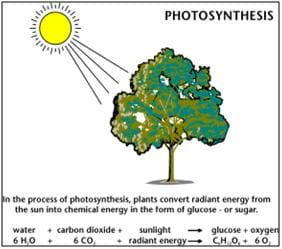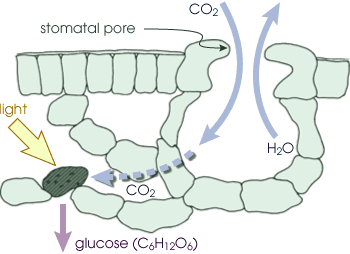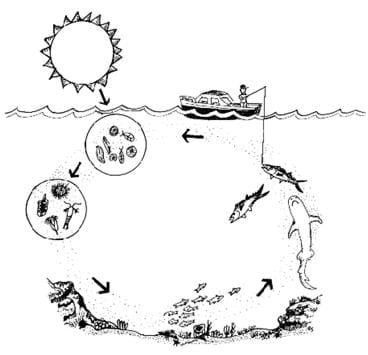Quick Look
Grade Level: 7 (6-7)
Time Required: 15 minutes
Lesson Dependency: None
Subject Areas: Biology, Life Science, Science and Technology
NGSS Performance Expectations:

| MS-LS1-6 |

Summary
This lesson covers the process of photosynthesis and the related plant cell functions of transpiration and cellular respiration. Students learn how engineers can view the natural process of photosynthesis as an exemplary model of a complex, yet efficient, process for converting solar energy to chemical energy or distributing water throughout a system.Engineering Connection
Engineers are faced with the challenge of designing energy efficient systems for heating buildings, for example, or creating fuel-efficient vehicles. The photosynthetic process serves as an excellent model for highly efficient engineering design. Plants convert readily available resources (water, sunlight and carbon dioxide) into plant fuel (glucose). The only byproduct of the process is oxygen, which is an environmentally friendly product that is consumable by other organisms. Engineers who are working to optimize fuel efficiency and minimize hazardous emissions can look to the effective process of photosynthesis as an example.
Learning Objectives
- Describe how the relationship between photosynthesis and respiration sustain life on this planet.
- Explain the relationship between plants and animals in the oxygen-carbon dioxide cycle.
- Identify ways in which engineers could utilize knowledge of photosynthesis.
Educational Standards
Each TeachEngineering lesson or activity is correlated to one or more K-12 science,
technology, engineering or math (STEM) educational standards.
All 100,000+ K-12 STEM standards covered in TeachEngineering are collected, maintained and packaged by the Achievement Standards Network (ASN),
a project of D2L (www.achievementstandards.org).
In the ASN, standards are hierarchically structured: first by source; e.g., by state; within source by type; e.g., science or mathematics;
within type by subtype, then by grade, etc.
Each TeachEngineering lesson or activity is correlated to one or more K-12 science, technology, engineering or math (STEM) educational standards.
All 100,000+ K-12 STEM standards covered in TeachEngineering are collected, maintained and packaged by the Achievement Standards Network (ASN), a project of D2L (www.achievementstandards.org).
In the ASN, standards are hierarchically structured: first by source; e.g., by state; within source by type; e.g., science or mathematics; within type by subtype, then by grade, etc.
NGSS: Next Generation Science Standards - Science
| NGSS Performance Expectation | ||
|---|---|---|
|
MS-LS1-6. Construct a scientific explanation based on evidence for the role of photosynthesis in the cycling of matter and flow of energy into and out of organisms. (Grades 6 - 8) Do you agree with this alignment? |
||
| Click to view other curriculum aligned to this Performance Expectation | ||
| This lesson focuses on the following Three Dimensional Learning aspects of NGSS: | ||
| Science & Engineering Practices | Disciplinary Core Ideas | Crosscutting Concepts |
| Construct a scientific explanation based on valid and reliable evidence obtained from sources (including the students' own experiments) and the assumption that theories and laws that describe the natural world operate today as they did in the past and will continue to do so in the future. Alignment agreement: Science knowledge is based upon logical connections between evidence and explanations.Alignment agreement: | Plants, algae (including phytoplankton), and many microorganisms use the energy from light to make sugars (food) from carbon dioxide from the atmosphere and water through the process of photosynthesis, which also releases oxygen. These sugars can be used immediately or stored for growth or later use. Alignment agreement: The chemical reaction by which plants produce complex food molecules (sugars) requires an energy input (i.e., from sunlight) to occur. In this reaction, carbon dioxide and water combine to form carbon-based organic molecules and release oxygen.Alignment agreement: | Within a natural system, the transfer of energy drives the motion and/or cycling of matter. Alignment agreement: |
International Technology and Engineering Educators Association - Technology
-
Biotechnology applies the principles of biology to create commercial products or processes.
(Grades
6 -
8)
More Details
Do you agree with this alignment?
-
Energy can be used to do work, using many processes.
(Grades
6 -
8)
More Details
Do you agree with this alignment?
State Standards
Colorado - Science
-
Compare and contrast the flow of energy with the cycling of matter in ecosystems
(Grade
6)
More Details
Do you agree with this alignment?
-
Gather, analyze, and interpret data regarding the basic functions of photosynthesis and cellular respiration
(Grade
7)
More Details
Do you agree with this alignment?
Pre-Req Knowledge
Background information on cells (eukaryotic and prokaryotic) may be helpful.
Introduction/Motivation
Imagine if you could simply stand in the sun, breath air, drink water and be able to produce all of your own food, never having to cook or go out to eat, never having to shop, and never having to decide what you will eat next. Technically, you would have to be green or, rather, your skin would have to contain chlorophyll—the substance that creates the green color in plants and some algae and protistans. We just described a process that uses chlorophyll; does anyone know the name of that process? (Answer: photosynthesis)
During the process of photosynthesis, a plant will make its own food, called glucose. How does it do this? Well, inside the plant cells, a chemical reaction takes place that uses sunlight to turn water and carbon dioxide into glucose and oxygen. The plant simply releases the oxygen, much in the same way that you and I breathe out carbon dioxide. The oxygen can then be breathed in by other organisms, like us! Plants and humans depend on each other by breathing in what others breathe out—precisely how most of the natural world works: the waste of one organism is the food of another.
It would be great if all of the products that engineers designed could produce such environmentally friendly and useful byproducts. In fact, engineers work to design highly efficient products with (and from!) reusable waste. For example, mechanical and chemical engineers who are working on developing hydrogen fuel cell cars have designed the new technology to give off water as its only byproduct. In addition, they are working to discover new means of fueling things, such as automobiles, and for heating and cooling systems for homes and buildings. Some engineers have employed the concept of biomimicry, whereby they attempt to model our designed energy systems after those that are naturally occurring, such as photosynthesis. What does it take to mimic nature to design something like biofuels? Following the lesson, students can help inform a design for a biofuel refinery by performing an experiment in the associated activity Corn for Fuel?! that studies the effect that a variable of their choice has on plant growth.
Lesson Background and Concepts for Teachers
Photosynthesis is a biochemical process in which plants, algae, some types of bacteria and protistans utilize the sun's energy to produce sugar/glucose. At this point, they undergo cellular respiration, which converts the glucose into ATP (adenosine triphosphate), which is the fundamental fuel of all living things. This chemical reaction takes place within the structure of the cell (see Figure 2). Chlorophyll, the green pigment of the plant, makes the conversion of energy from the sun to chemical energy possible. Interestingly, during this process, the plant will consume water and release oxygen, which many organisms need to survive.

The relationship of the food cycle is such that algae takes in sunlight to further its own growth and then becomes food for the brine fly and shrimp, for example, along with other water natives. In turn, the algae are dependent on the decomposable matter waste from the brine flies for their own nutrients.

Associated Activities
- Corn for Fuel?! - Students perform an experiment that studies the effect that a variable of their choice has on plant growth. They use the result to inform decisions about designing a biofuels refinery.
Lesson Closure
Photosynthesis is a great example of a highly efficient biological process that is good for the environment. Engineers can use a solid understanding of such biological processes to design more efficient and less environmentally damaging ways of meeting our needs.
Vocabulary/Definitions
adenosine triphosphate: A high-energy phosphate molecule required to provide energy for cellular function. Abbreviated as ATP.
byproduct: A secondary product of a given process.
cellular respiration: The process in which the chemical bonds of energy-rich molecules such as glucose are converted into energy usable for life processes.
photosynthesis: The process by which cells containing chlorophyll, such as green plants and algae, convert incident light to chemical energy; they create organic compounds from inorganic compounds, namely carbohydrates from carbon dioxide and water, accompanied by the simultaneous release of oxygen.
transpiration: The process by which plants give off water vapor into the atmosphere.
Assessment
Pre-Lesson Assessment
Discussion Question: Solicit, integrate and summarize student responses.
Have you ever wondered how a plant eats? How do you think it gets its food? Tell the students that in this lesson, we will learn about the chemical process that allows plants to make their own food.
Post-Introduction Assessment
Question and Answer: Ask students the answers to the following questions:
- What are the byproducts/outputs of photosynthesis? (Answer: oxygen and water)
- What is it about these byproducts that are different from the byproducts of say an automobile? (Answer: The byproducts of photosynthesis are food/nutrients for other organisms, while the byproducts of an automobile are mostly toxic to the environment.)
- What are the inputs for photosynthesis? (Answer: carbon dioxide, water and soil nutrients)
Note: It might be helpful to write down the outputs on the right side of the board/overhead, inputs on the left and then draw a plant in the middle, showing the entire process. The students can also take part in posting parts of the process on the board.
Lesson Summary Assessment
Diagramming: Have students individually diagram the process of photosynthesis indicating inputs and outputs. If time permits, have them include this diagram in a food web, illustrating the sun's input and several levels of consumers that utilize the plant, not only as a producer of oxygen, but also as a direct food source; for example rabbits or mice and then foxes, etc.
Subscribe
Get the inside scoop on all things TeachEngineering such as new site features, curriculum updates, video releases, and more by signing up for our newsletter!More Curriculum Like This

Students learn about photosynthesis and cellular respiration at the atomic level and study the basic principles of electromicrobiology—a new field of research that may enable engineers to harness energy at the molecular level.

Students gain an understanding of the parts of a plant, plant types and how they produce their own food from sunlight through photosynthesis. They learn how plants play an important part in maintaining a balanced environment in which the living organisms of the Earth survive. This lesson is part of ...

Through a teacher-led discussion, students realize that the food energy plants obtain comes from sunlight via the plant process of photosynthesis. By counting the number of bubbles that rise to the surface in a five-minute period, students can compare the photosynthetic activity of Elodea in the pre...
References
"Ecology of Gray's Reef." Last updated March 11, 2009. Gray's Reef National Marine Sanctuary, National Oceanic and Atmospheric Administration. Accessed March 30, 2009. graysreef.noaa.gov
"BIOMASS---Renewable Energy from Plants and Animals." Last updated November 2007. Energy Kids Page, Energy Facts, Energy Information Administration, U.S. Department of Energy. Accessed March 5, 2009. www.eia.gov/kids/index.cfm
Copyright
© 2009 by Regents of the University of ColoradoContributors
Christopher Valenti; Janet Yowell; Karen KingSupporting Program
Integrated Teaching and Learning Program, College of Engineering, University of Colorado BoulderAcknowledgements
The contents of this digital library curriculum were developed under grants from the Fund for the Improvement of Postsecondary Education (FIPSE), U.S. Department of Education and National Science Foundation (GK-12 grant no. 0338326). However, these contents do not necessarily represent the policies of the Department of Education or National Science Foundation, and you should not assume endorsement by the federal government.
Last modified: June 30, 2019







User Comments & Tips